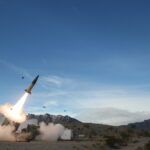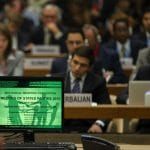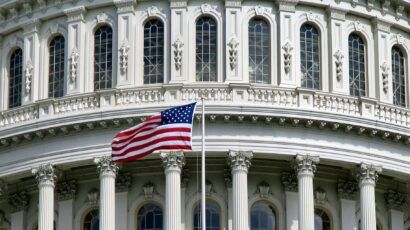The slow death of nonproliferation norms
By Charles P. Blair | May 4, 2018
If proven true, the Syrian government’s alleged use of chemical weapons would violate millennia-old taboos and long-standing legal prohibitions. The August 2013 chemical attacks in the eastern suburbs of Damascus—publicized worldwide through horrifying video of victims posted to the Internet—have drawn particularly fierce global condemnation. A United Nations investigative team also has been tasked with investigating a series of earlier alleged chemical attacks during the Syrian civil war. The Syrian government actually stands accused of using only a limited number of types of chemical weapons during its battles with rebel forces. Of the five weapon types the government reportedly has used, two are technically classified as non-lethal, and a third—white phosphorous—is not legally considered a chemical weapon. Moreover, two of the weapons allegedly used were likely misidentified. All but seven countries are members of the Chemical Weapons Convention (CWC), a 1993 arms control agreement that outlaws the production, possession, and use of chemical weapons. Syria is one of the nations that have not signed the CWC. Because of the all-but-universal taboo against the military use of poisons, the international response is likely to be harsh if investigation confirms that the Syrian government authorized the lethal use of any of the following weapons.
US President Donald Trump, over the course of 11 days in March, twice took actions that exemplified—albeit in Trump’s unique style—ongoing shifts in global norms regarding the possession and use of chemical weapons.
On March 9, the White House announced that Trump was willing to meet with North Korean leader Kim Jung-un—even though, just three days earlier, the State Department had announced its determination of North Korean culpability in the February 2017 assassination of Kim’s half-brother, Kim Jong-nam. (The latter Kim was attacked in a crowded Malaysian airport with VX—a persistent chemical warfare nerve agent many times more toxic than sarin.) Although North Korea is not a member of the Chemical Weapons Convention—a 1993 arms control agreement that outlaws the production, possession, and use of chemical weapons—Pyongyang acceded nearly three decades ago to the 1929 Geneva Protocol, nominally pledging to abstain from the use of “asphyxiating, poisonous, or other gases.”
On March 20, during a phone call to Russia’s president, Trump reportedly congratulated Vladimir Putin on his recent re-election—a common enough practice among US presidents, but one typically reserved for leaders of non-pariah nations. Russia on March 4 almost certainly attempted to assassinate a UK citizen with a chemical warfare nerve agent even more toxic than VX—so-called novichok. Russia, as a linchpin member of the Chemical Weapons Convention for more than two decades, has pledged never to develop, stockpile, transfer, or use chemical warfare agents.
The president’s actions could simply be interpreted as additional examples of behavior unprecedented among democratic leaders. But in fact, Trump’s actions are in line with a broad, ominous shift in international attitudes toward chemical weapons and their use. The shift is alarming enough in its own right—but changes in norms that stigmatize chemical weapons directly affect other, and collectively far more important, pillars of the nonproliferation regime. These include the Biological and Toxin Weapons Convention—a 1972 treaty prohibiting the development, production, and stockpiling of biological and toxin weapons—and the 1968 Nuclear Non-Proliferation Treaty, which allows member states full, cooperative access to nuclear technology for peaceful purposes while also limiting to five the number of states that can legally possess nuclear weapons.
As recently as 2012, few would have predicted such degeneration in the nonproliferation regime. Indeed, half a decade ago, the idea of possessing or using chemical weapons attracted nearly universal opprobrium. The Chemical Weapons Convention had entered into force in 1997, with all but three states eventually acceding to the treaty. This major achievement in arms control was possible because the international community had been sobered by the widespread use of chemical weapons in the Iran-Iraq War—and because the disintegration of the Soviet Union had made the undertaking politically viable. At the 2012 High-Level Meeting at the United Nations commemorating the 15th anniversary of the Convention’s entry into force, none other than Russia’s representative lauded the Convention as “one of the most efficient instruments of international interaction in the sphere of disarmament and nonproliferation,” going on to call chemical weapons “one of the most inhumane means of warfare.”
Future historians may well point to 2012 as a turning point—the moment when the taboo against chemical weapons began to erode.
Things fall apart. In December 2012, a year and a half into Syria’s civil war, reports emerged that the Syrian government had used chemical weapons. Additional reports emerged in 2013, reaching a crescendo in August when, according to US assessments, 1,429 people perished in a sarin-armed rocket attack targeting the opposition-controlled Damascus suburbs of Eastern and Western Ghouta. Then-President Obama faced the daunting task of enforcing a “red line” he had established against Syrian use of chemical weapons while simultaneously adhering to one of his principle second-term goals: keeping the United States out of another large-scale ground war in the Middle East. A solution of sorts was found: The United States, along with Russia, the United Nations, and the Organisation for the Prohibition of Chemical Weapons, worked out an agreement with the Assad regime whereby Syria putatively declared its entire chemical weapons stockpile for eventual destruction and concomitantly joined the Chemical Weapons Convention. (The Organisation for the Prohibition of Chemical Weapons is the international body tasked with aiding in and verifying compliance with the Chemical Weapons Convention.)
Unfortunately, it became obvious in subsequent years that Damascus was continuing its use of chemical weapons—largely the choking agent chlorine—against opposition forces and civilians. In addition, Syria was now receiving direct military assistance from Russia and, quite possibly, aid from North Korea in the form of equipment useful in producing chemical weapons. In April 2017, the young Trump administration was pressed to take action after the Assad regime was once again linked to the use of sarin, with at least 69 people dying as a result.
Trump’s response, a modest salvo of 59 Tomahawk cruise missiles, predictably failed to dissuade Damascus from additional use of chemical weapons; at least seven chemical attacks were linked to the regime in January and February of this year. Last month, after 70 civilians were suffocated in a chemical attack that likely involved chlorine-based chemical warfare agents delivered by Assad’s forces, Trump responded with a delayed and ineffectual cruise missile barrage. Trump declared “mission accomplished,” despite the historical baggage attached to that phrase, but in any case such a limited response would do little to deter the Syrian regime from using chemical weapons again.
Syria has now engaged in at least 50 chemical weapon attacks since December 2012, and likely many more. Damascus has learned that, despite chemical weapons’ widely assumed inappropriateness for the modern battlefield, the emerging realities of urban warfare confer renewed effectiveness on chemical warfare agents such as chlorine and sarin. Chlorine, for example, is 2.5 times heavier than air and can easily collect in subterranean rubble where armed, non-state adversaries might be ensconced. Such agents are also psychologically devastating to nearby civilians who might sympathize with the regime’s adversaries. This grim reality—together with the all-but-certain centrality of urban centers in future warfare—will likely render chemical weapons increasingly attractive to regimes engaged in internecine conflicts (and to their state backers).
Undermining everything. Russia, in addition to using its own chemical warfare agents as tools for assassination, has betrayed its solemn commitments under the Chemical Weapons Convention by enabling Syria’s use of chemical agents. Moscow’s actions have contributed to a growing, if tacit, acceptance of chemical weapons, which in turn carries corrosive consequences for the larger nonproliferation regime.
In a recent interview with this author, Daryl Kimball—executive director of the Arms Control Association—discussed Russia’s aberrant actions and their consequences. Kimball mentioned Russia’s “direct and destructive [undermining] of the institutions that are assigned to investigating [chemical weapon] use, ascribing responsibility, and holding perpetrators responsible.” Specifically, Kimball identified “Russia’s very systematic criticism of the [Organisation for the Prohibition of Chemical Weapons] and the [Russian-engineered dissolution] of the Joint Investigative Mechanism.” That mechanism, until its demise in November 2017, was a joint effort between the United Nations and the Organisation for the Prohibition of Chemical Weapons that sought to establish culpability for confirmed chemical weapon attacks in Syria.
In another interview, Gregory Koblentz—director of the Biodefense Graduate Program at George Mason University—discussed “just how little Russia cares about these norms and treaties.” As evidence he cited Russia’s willingness to discount Syrian violations of international norms and to actively shield Damascus from the consequences of violations—by, for example, undermining the Joint Investigative Mechanism, the Fact-Finding Mission, and the overall investigative process in Syria. Koblentz said that because of Russia’s willingness to undermine the chemical weapons regime, he is concerned that Moscow might also be willing to undermine the International Atomic Energy Agency and the Nuclear Non-Proliferation Treaty. Russia, Koblentz said, is “the principle vector for the erosion of norms across all the nonproliferation regimes.”
Conditional taboo. Like the Assad regime, terrorists are beginning to recognize novel and productive uses for two classes of chemical agents: weaponized toxic industrial chemicals and chemical warfare agents. Indeed, open-source datasets reveal that from 1970 through 2011, 233 incidents of terrorism involved chemical agents. From 2012 through April 2018, however, no less than 155 such incidents occurred—and likely many more. In other words, more than 40 percent of all reported terrorist incidents involving chemical agents since 1970 have occurred in the past six years. Of course, this dramatic shift is to a large extent attributable to the Islamic State—a group that has consistently demonstrated operational and innovative capabilities of the first order.
The Islamic State is now on the wane—but violent non-state actors, just like organizations of other types, learn from and emulate one another. Moreover, actions that a certain generation of terrorists might perceive as “beyond the pale” are sometimes considered fair play by future generations. In short, despite the Islamic State’s acute weakening over the last three and a half years, incidents in which terrorists utilize chemical agents—especially chlorine, a prodigiously available agent with broad legitimate uses—are likely to remain high when compared to pre–Islamic State levels. If that’s so, tacit acceptance of chemical weapon use can only rise.
As a colleague and I argued in the Bulletin after the last incident of mass sarin exposure, in April 2017, opprobrium against the use of chemical weapons is an “immensely emotional taboo … and one so normalized that, most of the time, it is an unspoken, unexamined assumption.” But as the political scientist Michelle Bentley has pointed out regarding the Obama administration’s ultimately vacuous “red line,” Obama’s “hesitance to intervene once that line had been crossed suggests that the taboo is somewhat conditional, or at least that policy makers” are not always eager to recognize it. In fact, when one objectively assesses the effects of chemical weapons—in comparison, at least, to the effects of conventional weapons—it is by no means obvious why chemical weapons should be taboo. Recall the images you have seen in the media depicting dead children in Syria. More likely than not, such images have shown victims of chemical weapons. Infants are poisoned by chemical weapons far less often than they are blown to bits by conventional weapons—but images that depict child victims of conventional arms are deemed too graphic for public consumption.
The chemical weapons taboo, then, is socially constructed—and as such, it has been institutionalized. But as sociologists Peter Berger and Thomas Luckman demonstrated in their seminal 1966 treatise The Social Construction of Reality, “Institutionalization is not… an irreversible process. … Since human beings are frequently sluggish and forgetful, there must also be procedures by which [institutionalized] meanings can be re-impressed and rememorized.”
Kimball echoed this sentiment. “Norms don’t enforce themselves,” Kimball said, “and the [chemical weapons] taboo is basically 100 years old. … [A]s new generations come along, the horrors of past WMD use get forgotten, or are never learned.” Kimball pointed out that the same problem pertains where nuclear weapons are concerned. “[W]ith a now 70-plus-year history of [nuclear] non-use, fewer and fewer students realize the destructive power of nuclear weapons.”
Who’s the enforcer? Berger and Luckman, discussing how normative behaviors emerge and change, noted that “He who has the bigger stick has the better chance of imposing his definition of reality.” Since the end of World War II, the United States has had the biggest “stick”—but the stick isn’t what it used to be. Is it a coincidence that the decline of normative international behavior is arising in an epoch of declining US power?
Seeking insight into this question, I spoke with Christopher Preble, vice president for defense and foreign policy studies at the Cato Institute. “We’re on a treadmill,” Preble said. “[The United States seems] to be running harder, but we are staying still, while other states don’t have to spend as much as we do to achieve their ends, which are more defensive in nature.” According to Preble, that is why the Pentagon, along with Trump’s national security team, so heavily emphasize “over-match.” US military planners “don’t want a fair fight” because “[p]ublic support [for military endeavors] is fairly soft.” The danger, Preble says, is that the US public will perceive many conflicts as not worth fighting—and “US military planners never want to confront such a situation.”
What does all this mean for the nonproliferation regime? According to Preble, if the United States is to engage in enforcement of international instruments such as the Chemical Weapons Convention or the Biological and Toxin Weapons Convention, with no compelling vital US interest at stake, “Americans will only be willing to tolerate such actions if the costs and risks are low.” But “pinprick operations” such as those launched against Syria by the Trump administration “are unlikely to send the message that… the use of chemical and biological weapons is extraordinarily bad… . In the end, it all just becomes a symbolic dance.”
It seems unlikely that any nation other than the United States—or any realistic confederation of nations—can enforce nonproliferation norms. But Preble’s accurate assessment of the US public’s opposition to costly military endeavors implies that Washington itself will not play that role except against truly existential threats—or unless, as was the case with the Iraq War, US policy makers can disingenuously and disastrously sell such a threat to the public.
Consider Trump’s acutely foolish opposition to the Iran nuclear deal (formally known as the Joint Comprehensive Plan of Action). If Trump withdraws from the deal, the administration will undoubtedly market his ill-advised action as a defense of international norms—saying something such as “Iran is already cheating, so we need to get much tougher to stop them from going nuclear and threatening global security.” But the effect might be to trigger proliferation. Tehran might conclude that US policy makers seek to overthrow the Iranian regime no matter what, and react by developing a genuine, robust nuclear weapons program that functions as an “anti-occupation device,” thereby thwarting perceived US intentions. North Korea, meanwhile, would take careful note of Washington’s withdrawal from a nuclear deal to which, by any reasonable account, Iran is adhering. Consequently, the North Korean regime—even if today it genuinely intends to pursue denuclearization—could reasonably conclude that its security interests are best met by maintaining a nuclear capability. The irony, of course, is that any US military action against Iran, North Korea, or both would come wrapped in the cloak of norm enforcement—when, quite likely, Trump’s own pursuit of non-normative policies would cause North Korea to keep its nuclear weapons program and Iran genuinely to pursue a program of its own.
Then again—as Preble suggested in our conversation—if one day the United States takes military action against a genuinely existential WMD threat, norm enforcement won’t be the point. It will just be realism in action.
Together, we make the world safer.
The Bulletin elevates expert voices above the noise. But as an independent nonprofit organization, our operations depend on the support of readers like you. Help us continue to deliver quality journalism that holds leaders accountable. Your support of our work at any level is important. In return, we promise our coverage will be understandable, influential, vigilant, solution-oriented, and fair-minded. Together we can make a difference.















